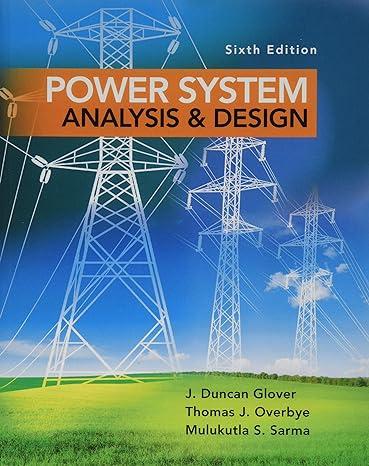The power flow at any point on a transmission line can be calculated in terms of the
Question:
The power flow at any point on a transmission line can be calculated in terms of the \(A B C D\) parameters. By letting \(A=|\mathrm{A}| \angle \alpha, B=|B|\left\langle\beta, \mathrm{V}_{\mathrm{R}}=ight.\) \(\left|\mathrm{V}_{\mathrm{R}}ight| / 0^{\circ}\), and \(\mathrm{V}_{\mathrm{S}}=\left|\mathrm{V}_{\mathrm{S}}ight| / \delta\), the complex power at the receiving end can be shown to be
\[
\mathrm{P}_{\mathrm{R}}+j \mathrm{Q}_{\mathrm{R}}=\frac{\left|\mathrm{V}_{\mathrm{R}}ight|\left|\mathrm{V}_{\mathrm{s}}ight| / \beta-\alpha}{|\mathrm{B}|}-\frac{|\delta|\left|\mathrm{V}_{\mathrm{R}}^{2}ight| / \beta-\alpha}{|\mathrm{B}|}
\]
(a) Draw a phasor diagram corresponding to the above equation. Let it be represented by a triangle \(\mathrm{O}^{\prime} \mathrm{OA}\) with \(\mathrm{O}^{\prime}\) as the origin and \(\mathrm{OA}\) representing \(\mathrm{P}_{\mathrm{R}}+j \mathrm{Q}_{\mathrm{R}}\).
(b) By shifting the origin from \(\mathrm{O}^{\prime}\) to \(\mathrm{O}\), turn the result of part
(a) into a power diagram, redrawing the phasor diagram. For a given fixed value of \(\left|V_{R}ight|\) and a set of values for \(\left|V_{S}ight|\), draw the loci of point \(A\), thereby showing the so-called receiving-end circles.
(c) From the result of part
(b) for a given load with a lagging power factor angle \(\theta_{R}\), determine the amount of reactive power that must be supplied to the receiving end to maintain a constant receiving-end voltage if the sending-end voltage magnitude decreases from \(\left|\mathrm{V}_{\mathrm{S} 1}ight|\) to \(\left|\mathrm{V}_{\mathrm{S} 2}ight|\)
Step by Step Answer:

Power System Analysis And Design
ISBN: 9781305632134
6th Edition
Authors: J. Duncan Glover, Thomas Overbye, Mulukutla S. Sarma




